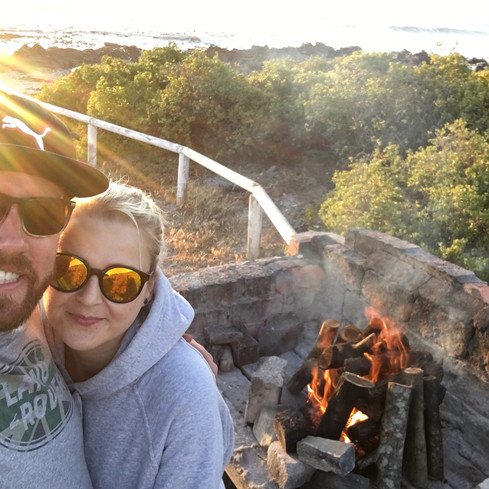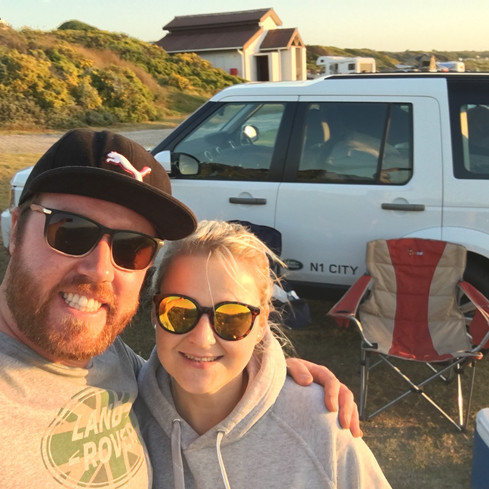West Coast for the Weekend Warrior
- Anton Pretorius
- Jan 2, 2018
- 6 min read
The Cape West Coast, the quintessential ‘road less travelled’ is tailor-made for a good old-fashioned road trip. A Landy Discovery and any given day of the week are good enough reasons to head up there.

Our decision to break away to the West Coast for a ‘rough-it-out’ weekend was an impulsive one. My wife and I decided it was time to blow off some steam and exchange our computer screens for a weekend in the wilderness.

The Cape West Coast is as beautiful as it is barbarous. Well-loved for its rustic and sleepy seaside villages, it is also renowned for its rugged and inaccessible sand-blasted terrain, with an unfathomable abundance of empty spaces along its windswept coastline.

But driving along the straights at a certain time of year (August to December) you’ll notice a tapestry of wild flowers lie strewn across the platteland like a kaleidoscope of colourful patchwork blankets. We soon found ourselves surrounded by undulating landscapes, remote countrysides and plenty of lethargic sheep baking under a hot sun.

To the left, we glimpse the ocean in the distance and we knew we were close. White sand beaches and stony shores are relentlessly hammered by the angry Atlantic. Foiled by fog, strong currents and rocky reefs, the West Coast has a notorious history of claiming many careless sailors, evident in the number of shipwrecks littered along its coastline.

The unassuming seaside parish of Yzerfontein is often the first refuge for travellers (an hour’s drive from Cape Town), but there’s another little retreat that people often miss. It’s a peaceful little paradise called Ganzekraal Coastal Resort – a well-hidden municipal resort that hugs the shoreline.

Our touring wheels - a Land Rover Discovery 4 SDV6 HE - was generously loaned to us by Jaguar Land Rover N1 City and its affable dealer principal, Riaan Launspach. True, her price tag might seem hefty, but the Disco offers plenty of bang for buck, seamlessly fusing in-cabin luxury with utilitarian-like off-road capability and still able to offer a smooth, comfortable driving experience on the tarmac.

Upon arrival, we immediately rued our decision of a 'rough-it-out' weekend. The West Coast is notorious for its extreme summer winds and a gale-force southwesterly of nearly 60 km/h was ripping through our campsite.
Later on, I notice a mob of amused onlookers gathering around us. Several unsuccessful attempts at pitching our two-man tent, while holding it down with coolerboxes and camping chairs, proved to be a great source of entertainment for our fellow campers. There were moments where the idea of just letting go and watching the tent blow into the ocean would have been a very satisfying sight.

An hour later we threw in the proverbial towel, which left us in a very precarious position. We had no roof over our head, no shelter from the wind and the sun was setting fast. The situation worsened when a fellow camper sympathetically told us that the noise from his tent flapping furiously in the wind kept him up all night.
As the sun set and the temperature dropped, my wife resorted to wrapping herself up head-to-toe in a blanket like an Inuit, peering at me with 'dagger-eyes' through a small opening. Not exactly a ‘happy camper’.

Admiring our spacious Disco, a light bulb immediately went off. I flattened the seats, took the inflatable queen-sized mattress and placed it squarely inside the back of the vehicle. We connected the air-pump into the 12-volt cigarette lighter (conveniently placed in the back) and voilà, completely inflated, the mattress fit snugly in the back of the car.
The Disco was parked closer to our braai, positioned at an angle that sheltered us from the wind. We spent the evening around the campfire, enjoying a tasty supper of lamb chops, green salad and a dram or two. At last, we were content with our arrangements - all thanks to the Disco!

When we eventually decided to hit the sack, we crawled into the car – now dubbed the ‘Disco Hotel’. That night, from within the confines of the Discovery 4, it was as if the wind never blew, even though we could hear it outside, blustering at the
rate of untold knots.

We woke up the next morning to the sights and sounds of waves crashing on the beach, a mere 20 metres from where we were sleeping. We felt well-rested and very impressed with the Discovery’s sleeping arrangements. I don’t care if your tent is made from military-grade canvas, this was a far better shelter than any tent could have offered us.
This was the cherry on top of an already impressive Disco. In our time of need, it came to our rescue. I think it’s safe to say that any weekend warrior couple – those who enjoy camping occasionally – will never need to buy a tent again (or a caravan for that matter!) or even spend unnecessary money on lodging if they own a Land Rover Discovery.
It’s a bold statement and I’m sure many will disagree. But if you're in dire need of quick getaway to escape the pressure and stress of everyday life, the Land Rover Discovery is a sound investment. Arrange sleepovers for the kids, pack a few essentials (camp chair, cooler box) and off you go!
Gone are the days of schlepping your caravan (including your entire home contents) to your camping spot. With a Discovery, you can allow yourself more time to enjoy your weekend rather than spend half of it setting up and breaking down camp.
No disrespect to the hardcore camper who spends more than half the year calling his camp site ‘home’ and even enjoys decorating it with white picket fences and garden gnomes. Even for these campers, a Discovery hold tremendous value as a towing vehicle and comfortable drive for those long days on the road.
If you’re a weekend warrior looking for any good excuse to break away for the weekend, perhaps with a cooler box and few fishing rods, the Land Rover Discovery 4 doubles up as both a smooth ride and comfortable sleeping quarters if need be. The versatility is endless.
Wing it, the West Coast Way
South Africa’s Western Cape is full of famously delightful areas, such as the Winelands and Garden Route, but the West Coast remains somewhat of a local secret. Here are some interesting must-visits when you're in the area.

This is West Coast, Darling!
The quaint little town of Darling deserves a stop. It might only be an hour from Cape Town, but it’s a world away. Famous for its wild flowers, museums and creamery, Darling has a tangible sense of history. Make sure you visit South African satirist Pieter-Dirk Uys/Evita Bezuidenhout’s Evita se Perron – a cabaret venue and restaurant situated on the town’s train station, and the Darling Brew Tasteroom & Brewery.
National Treasure
The West Coast National Park, which stretches from Yzerfontein to Langebaan, is a pristine nature reserve that offers an array of activities such as birdwatching, game sighting, biking and whale spotting. Avid birdwatchers can spot over 200 species of land and sea birds, and game includes gemsbok, kudu, springbok and the rare mountain zebra. The popular restaurant, Geelbek, is situated near the Langebaan lagoon.

Culture trip!
The !Khwa ttu San Cultural and Educational Centre offers a fascinating insight into the culture, heritage, knowledge and modern-day life of the original inhabitants of the West Coast. Tours by qualified San guides demonstrate their unique skills and share their ancient knowledge. They also offer a spectacular mountain biking trail, accommodation and the original farmhouse is now a beautiful restaurant that is open for breakfast and lunch daily.
Easy Seaside Livin’
The picturesque seaside village of Yzerfontein is not only a haven for birdlife, wildlife, sea life and indigenous flora, it also boasts South Africa’s longest stretch of beach, which runs for 25km – all the way up to the start of the West Coast National Park in the north. Popular with water sport enthusiasts, other activities include whale spotting, fishing and hiking.

West Coast Fossil Park
Millions of years ago, the West Coast landscape was dominated by riverine forests, wooded savanna and inhabited by animals that are now long extinct. Mining in the 1950s exposed one of the richest fossil deposits ever discovered and the property is now a national heritage site. There is an ongoing excavation of early Pliocene fossils and guided tours offer a background to the fossils as well as the climatic changes that have happened. There are also several mountain biking and hiking trails.





















Comments